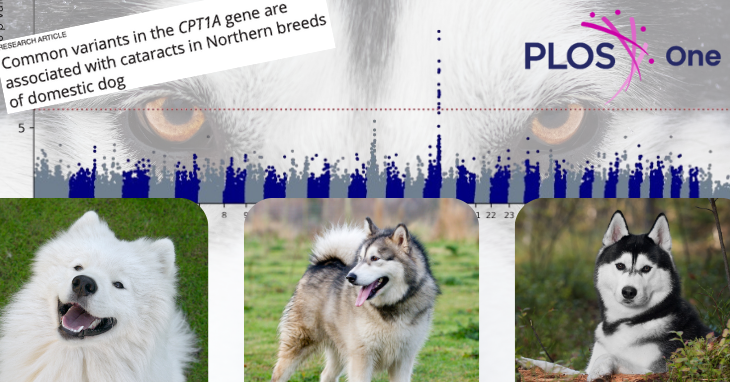
The Canine Genetics Centre has a successful track record investigating the genetic basis of inherited eye diseases in dogs. However, some eye diseases have been more challenging to investigate than others, and cataracts have been no exception. Many breeds are predisposed to develop inherited forms of cataracts, but their inheritance is generally more complex than for other eye diseases, such as progressive retinal atrophy, so identifying underlying genetic risk factors is harder.
But earlier this week we finally published an association that we found between the CPT1A gene and cataracts in Northern breeds of dog. The work was published in the peer-reviewed, open access journal, PLOS One.
Ricketts SL, Ahonen S, Pettitt L, Freyer J, Ellis S, Jenkins CA, Kaukonen M, Boursnell M, Schofield E, Forman OP, Lohi H, Mellersh CS. Common variants in the CPT1A gene are associated with cataracts in Northern breeds of domestic dog. PLoS One. 2025 Apr 4;20(4):e0320878. doi: 10.1371/journal.pone.0320878.
Hereditary cataracts affect some Northern breeds of dog, such as the Siberian Husky, Alaskan Malamute and the Samoyed, and disease progression can vary. In partnership with Wisdom Panel, we undertook a genome-wide association study (GWAS) to search for genetic loci associated with cataracts in these breeds. A significant peak was found on chromosome 18 in the Siberian Husky, which we were able to replicate in a larger case-control set of data. Whole-genome sequencing (WGS) of cataract cases allowed us to fine-map the region and to search for candidate variants. An area encompassing the CPT1A gene was strongly associated in multiple breeds, which we were able to demonstrate was expressed in parts of the dog’s eye (lens and retina) via RNAseq.
This is exciting work showcasing novel findings of a potentially new locus for cataracts in dogs, but further work needs to be undertaken to better understand the underlying physiological processes as well as discovering the causal variant(s).
Data from this study indicates that cataracts in these breeds is almost certainly a complex disease with multiple susceptibility alleles, some of which are common within breeds, possibly even combined with environmental factors. These findings are not suitable to be used in isolation as a selective breeding tool, but we hope to continue our work to tease apart the genetics of inherited cataracts in these and other breeds and develop breeding tools that are suitable for breeders to use to reduce the incidence of cataracts without compromising the genetic diversity of their breeds.
The Canine Genetics Centre would like to thank our partners, Wisdom Panel, for this exciting collaboration, and all the ophthalmologists, and dog owners and breeders who have submitted DNA samples from their patients and pets to contribute to this work over the many years that it has been ongoing.

